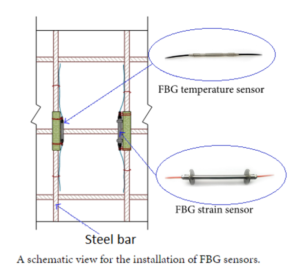The well integrity has become a critical concern after recent events in the oil industry, such as oil spills. The interaction of a salt layer with the cement and casting for Pre-salt wells is a concern for fiber optic well monitoring and the structural integrity of the well. The development of continuous monitoring tools for well structural integrity is an ongoing task for the oil industry.
Continuous fiber optic well monitoring has the advantage of allowing the quantification of the time needed for an event. Casting integrity logging operations may provide information regarding the damage location, however, the time in the life of the well when the damage happened or the process of the well degradation can not be determined. The logging operations can only provide information on the condition of the well at a particular time, not continuously. Continuous monitoring can help to correlate well damage and events that could be the cause of the damage, like outside intervention, allowing for corrective and preventive measures to take place.
The two main parameters that need to be measured are strain and temperature. The strain in fiber optic well monitoring can indicate the strain in the casting that is caused by the creep of the salt layer. Distributed temperature sensing may be used to indicate the positioning of the cement slurry, diagnose the curing process, and indicate the cementing failures.
The sensors need to be installed outside the production casing of the production liner. The size of the sensors, therefore, is required to be small. DTS sensors, in particular, are compact and are easy to install onto any surface. However, the mounting process of the sensors needs to be delicate as the casing properties may degrade. Fiber optic well monitoring solutions shouldn’t be intrusive as the sensors could potentially cause issues, like poor isolation.
Optromix, Inc. is a U.S. manufacturer of innovative fiber optic products for the global market, based in Cambridge, MA. Our team always strives to provide the most technologically advanced fiber optic solutions for our clients. Our main goal is to deliver the best quality fiber optic products to our clients. We produce a wide range of fiber optic devices, including our cutting edge customized fiber optic Bragg grating product line and fiber Bragg grating sensor systems. Optromix, Inc. is a top choice among the manufacturers of fiber Bragg grating monitoring systems. If you have any questions, please contact us at info@optromix.com


 Nowadays, numerous civil infrastructures have been built in metropolitan areas all over the world. The performance of these infrastructures during construction, operation, maintenance, and upgrading is a major concern for society. The use of smart
Nowadays, numerous civil infrastructures have been built in metropolitan areas all over the world. The performance of these infrastructures during construction, operation, maintenance, and upgrading is a major concern for society. The use of smart  The FBG structure can change with the use of the refractive index, or the grating period. The grating period can be uniform or graded, and either localized or distributed in a superstructure. The refractive index has two main features, the refractive index profile, and the decline. The refractive index can be uniform or apodized, and the refractive index decline is positive or zero.
The FBG structure can change with the use of the refractive index, or the grating period. The grating period can be uniform or graded, and either localized or distributed in a superstructure. The refractive index has two main features, the refractive index profile, and the decline. The refractive index can be uniform or apodized, and the refractive index decline is positive or zero.